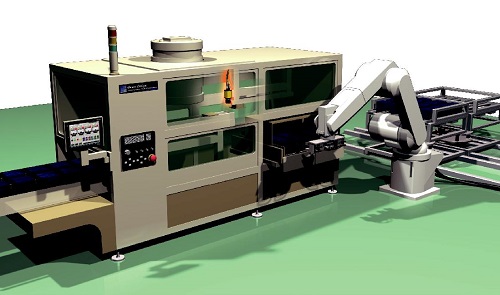
SOLUTION
- Q Series Automation Platform
- MR-J3 Servo Drives
- SSCNET III
ADVANTAGES
- Fast processing speed
- Multi-user capabilities
- Electrical noise immunity
BENEFITS
- Higher machine throughput
- Rapid development
- Improved reliability
Challenge
When a startup photovoltaic (PV) manufacturing company had proven its process in the lab, they turned to Owens Design, Inc. (ODI, www.owensdesign.com) in Fremont, CA to automate their I-V Flash Test and Sort process. The system involves taking the fragile photovoltaic cells from a dual-lane infeed, testing the cells, and then sorting them by performance into one of 8 outfeed lanes. High throughput and reliability were key design goals as well as rapid deployment of the first system.
Background
Integrating the conveyor systems, metrology hardware, PC interface, recipe handling, and motion control required that several engineers work simultaneously on various components. Communicating with these sub-systems using a single PLC program would present huge challenges, so the decision was made to use multiple CPUs on a single rack, each capable of running multiple tasks.
Solution
The Q Series Automation Platform from Mitsubishi Electric Automation was chosen for its processing speed, compact size, and software capabilities. In particular, the Q Series Automation Platform allows multiple users to connect to the system, taking full advantage of all available engineering resources during the critical test and debug phases of development. The modular program architecture simplifies the logic and machine sequencing, while a separate motion CPU’s sequential flow chart programming language allows for rapid program development. Doug Putnam-Pite, Director of Software Development, said “An integrated motion control system supplied by a single vendor reduced development time and provided a robust tool for our customer. Auto tuning of motors worked well and along with the ability to download parameters system setup was easy and fast.”
The motion CPU retains all of the servo parameters and sends them to each MR-J3 servo drive over the SSCNET III fiber optic network, eliminating the need to connect a PC to each servo drive individually. Data is transmitted at 50Mbps with a deterministic update time of 0.44ms for excellent coordination of axes with real-time status and diagnostic information. When discussing the benefits of SSCNET III, Bob Fung, VP of Engineering at ODI said “The simple connection method greatly reduced wiring and system debug time. We also saved time and improved reliability by eliminating electrical noise that plagues traditional servo systems.”
Results
With Mitsubishi’s powerful multi-CPU platform and SSCNET III fiber optic motion network, ODI was able to complete the prototype system in just 18 weeks. The SSCNET III connection to the MR-J3 servos reduced the total wiring by 25% and the noise immunity improved reliability by 30%. The modular programming style, multi-user interface, and simplified wiring reduced design time by 15% and debugging time by 30%. The prototype system met all cycle time and yield goals, and ODI has begun full production of the fully automated PV Flash Tester.

